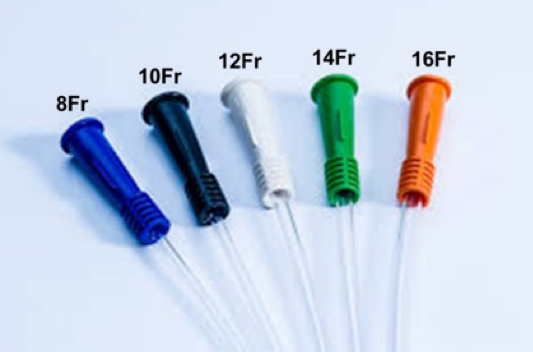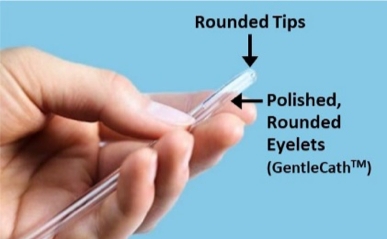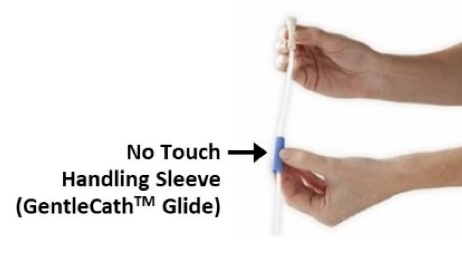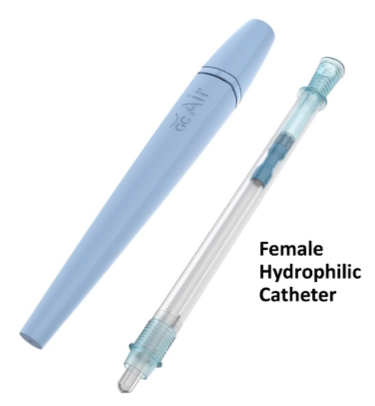
Catheter Length:
Catheter types are now gender specific, acknowledging the anatomical differences in urethral length between men and women.
- Standard male catheter length is 16” (~40-45cm)
- Female catheters range in length from 6-12 (20-26 cm)
- Pediatric lengths are 6-10”.
Catheter Size:
A catheter used for intermittent catheterization has single lumen. The diameter is measured in the French catheter scale, French gauge (Fr or F), or Charriere (Ch), based on the cross sectional diameter of the catheter in millimeters, similar to the size of indwelling urinary catheters. Sizes range from 6-12 French for children and 14-22 French for adults. The funnel end of the catheter is often color coded to allow for easier size identification. The funnel color of the shorter length catheters used by many women may not indicate the size and have been designed for ease of grasping the catheter.

Catheter eyelets:
There are two eyelets of urinary catheters which may be placed laterally or opposing. Larger size catheters do not necessarily have larger eyelets in proportion.

Catheter tip:
The tip of a catheter can be either straight (Nelaton) or curved (referred to as “Coudé or “Tiemann”). But all have a rounded tip allowing for smoother passage during insertion. There are catheters available to patients performing ISC that have an introducer tip that bypasses the part of the urethra that is colonized with bacteria during insertion. This prevents introducing bacteria into the bladder when catheterizing.

“No-touch” or “Touchless” catheterization
A unique feature of most catheters is the ability to insert the catheter without touching the surface. To ensure a “touch-free” insertion some have a plastic sheath (sleeve) that covers the entire catheter, sliding down to the funnel during insertion. Many have an insertion aid, a special guide mechanism or “finger grip” that slides along the catheter while it is inserted.

Packaging
Catheters are available that have compact packaging. Some are sold individually packaged, and can be easily carried in a purse ., even lipstick-sized length, or pocket. The packaging resembles cosmetic items that can be discreetly stored. These are more convenient and more discreet accommodating a person’s social and work life.

Intermittent Catheter Designs
There are two main designs of catheters used for intermittent bladder drainage: coated and uncoated. Catheter material and coatings are used for different types of catheters and are manufactured from latex, rubber, silicone, or polyvinylchloride (PVC). Catheter material or type influences rigidity.

Uncoated/Non-coated
Uncoated/Non-coated catheters require separate or external gel for lubrication. Lubricant may be packaged with the catheter. These catheters are often part of straight catheter sets or kits used in hospital. Uncoated red rubber latex catheters are uncoated catheters and are not appropriate for anyone with latex sensitivities and the flexibility of a red rubber catheter can make it difficult to insert.
Coated
Coated catheters are designed to improve catheter lubrication and ease insertion, which may reduce trauma and urinary tract infections. The most common coating is a hydrophilic coating as there is evidence supporting single-use HC catheters’ ability to prevent some of the most common catheter-associated complications, such as urethral trauma and CAUTIs.
There are different types of coating:
- Gel prelubricated catheters are safe, effective, and a comfortable option as results are significantly better compared to an uncoated catheter (Giannantoni et al., 2001; Sarica et al., 2010).
- Hydrophilic coated catheters have been shown to cause less urethral trauma and catheter-associated UTIs than the uncoated catheter (Christison et al, 2018; DeFoor et al, 2017; Shamout et al, 2017; Prieto, et al, 2015, Cardenas et al., 2011). They have one of the following coating designs:
- Surface hydrated with an integral lubricated surface and ready to use when opened
- Surface not activated but includes a sachet of sterile water that activates the coating when pressed or
- Surface activated when water added by the user
March 2021
© 2021 Digital Science Press, Inc. and UroToday.com


